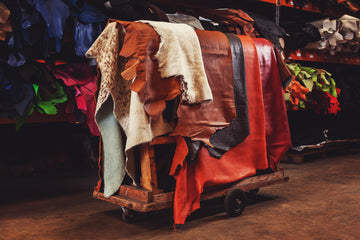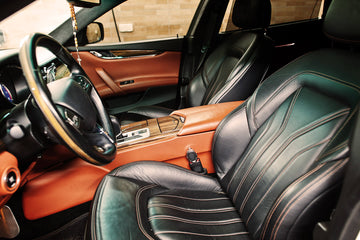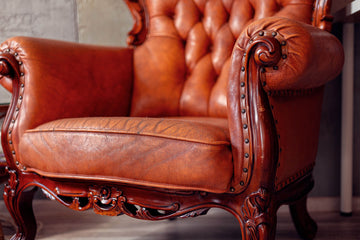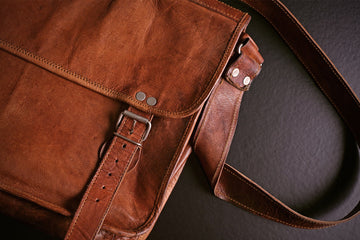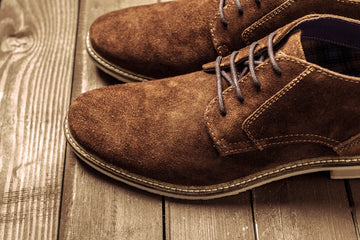When shopping for luxury leather goods or premium car seats, you've likely encountered the term nappa leather. Nappa leather is a generic term used in the leather industry to describe a class of luxury leathers known for their softness, smoothness, and strength. This exceptional material represents the pinnacle of leather craftsmanship, combining buttery texture with remarkable durability.
Understanding what makes nappa leather special can help you make informed decisions whether you're investing in a luxury handbag, upgrading your car's interior, or selecting premium furniture.
Nappa leather stands out from other leather types due to its distinctive softness, smooth texture, and pliable characteristics. From its origins in California's Napa Valley to its current status as the premium material of choice for discerning consumers alike, this comprehensive guide explores everything you need to know about nappa leather.
Introduction to Luxury Leather
Luxury leather has long been synonymous with sophistication and timeless elegance, and nappa leather stands at the forefront of this tradition. Crafted from full-grain leather, nappa leather is celebrated for its characteristic softness and smooth texture, making it a premium material of choice for discerning consumers.
The history of nappa leather is rooted in innovation, dating back to the late 19th century when German tanner Emanuel Manasse introduced a revolutionary chrome tanning process in California's Napa Valley. This breakthrough gave rise to nappa leather's signature pliability and luxurious appearance.
What sets nappa leather apart is its ability to retain the natural grain of the animal hide while achieving an exceptionally soft texture. The specialised tanning process, often involving chrome tanning, ensures that nappa leather remains both supple and durable, ideal for high-end fashion, accessories, and automotive interiors.
To care for nappa leather and preserve its luxurious look, it's essential to use a soft cloth and a leather cleaner specifically formulated for delicate, full-grain leathers. Regular conditioning helps maintain the smooth texture of nappa leather goods, ensuring they continue to exude timeless elegance for years to come.
Definition and Key Characteristics
Nappa leather is a premium full-grain leather known for its exceptionally soft, smooth texture and luxurious feel. Unlike other leather products, nappa leather maintains the natural grain of the animal hide while achieving an unparalleled level of softness through specialised processing techniques.
The exceptional softness of nappa leather is renowned for imparting a luxurious feel that is highly desirable for high-end products, such as gloves, car seats, and fashion accessories, making softness a key feature that underscores its premium quality.
The characteristic softness of nappa leather comes from its unique production method, which typically involves chrome-tanned processes using chromium salts. This tanning process creates a material that's both highly flexible and remarkably durable, making it a desirable choice for luxury applications ranging from automotive industry interiors to high-end fashion accessories.
Key characteristics that define authentic nappa leather include:
- Buttery texture: The smooth leather surface feels incredibly soft to the touch
- Natural grain retention: Unlike corrected grain leather, nappa preserves the hide's original markings
- Superior pliability: The material can be easily shaped and moulded without cracking
- Water resistance: Chrome tanning provides inherent protection against moisture
- Breathability: Natural pores remain intact, allowing air circulation
History and Origins of Nappa Leather
The history of nappa leather traces back to 1875 in California's Napa Valley, where a German tanner named Emanuel Manasse, working for the Sawyer Tanning Company, revolutionised leather production. Manasse developed an innovative tanning process that combined traditional techniques with new chemical treatments, creating leather with unprecedented softness and durability.
Originally, nappa leather was created using a combination of vegetable tanning and alum salts, primarily for luxury gloves that required exceptional flexibility and comfort. The term "nappa" derives from the Napa Valley location where this breakthrough occurred; however, the spelling has evolved, with some manufacturers using "Napa leather" as an alternative.
The evolution from its humble beginnings to modern applications showcases remarkable innovation. While early nappa leather relied on vegetable tanning methods, contemporary production has embraced chrome tanning techniques that enhance both the material's performance characteristics and production efficiency. This shift has enabled nappa leather to become the premium material of choice for automotive manufacturers, luxury fashion brands, and high-end furniture makers.
Skilled artisans working with raw hides in the early days established quality standards that continue to influence modern production. The meticulous attention to detail required to transform animal skins into the smooth, supple material we know today demonstrates the craftsmanship heritage that makes nappa leather so valued.
Manufacturing Process
The transformation of animal hide into luxury Nappa leather involves a sophisticated multi-stage process that requires both technical expertise and careful quality control. Nappa leather is made through a series of specialised steps—including tanning, softening, and finishing—to achieve its renowned softness, durability, and luxurious appearance.
Understanding this process helps explain why nappa leather commands premium pricing and delivers superior performance characteristics.
Hide Selection and Preparation
The manufacturing process begins with careful selection of raw hides, typically from young animals, including calves, lambs, and kid goats. These younger animals produce hides with finer grain structure and natural characteristics that contribute to the final product's superior qualities. The selected hides undergo thorough cleaning and preparation to remove any impurities that could affect the final texture.
Chrome Tanning Process
Nappa leather is typically chrome-tanned, meaning the signature softness of nappa leather results from chrome tanning using chromium salts rather than traditional vegetable tanning methods. This chemical process penetrates deep into the hide's fibre structure, creating cross-links that enhance both flexibility and strength. The chrome tanning process typically takes 12-24 hours and must be managed properly to achieve consistent results.
Neutralisation and Softening
Following the initial tanning, the leather undergoes neutralisation to balance pH levels and prepare it for finishing treatments. Mechanical and chemical softening processes further enhance the material's pliability, creating the characteristic smooth texture that distinguishes nappa leather from other types of leather.
Dyeing and Finishing
Water-soluble colourants penetrate the leather structure to achieve rich, consistent colouration while maintaining the natural grain pattern. Unlike surface-applied pigments, these dyes work with the leather's natural characteristics to create depth and richness in the final appearance.
Quality control measures throughout the manufacturing process ensure that every piece meets the rigorous standards expected of nappa leather products. This attention to detail enhances the material's reputation for excellence, justifying its premium position in the market.
Types of Nappa Leather
Understanding the various types of nappa leather enables consumers to make informed choices tailored to their specific needs and preferences. Each type offers distinct advantages and characteristics that make it suitable for different applications.
Aniline Nappa Leather
Aniline leather represents the most luxurious category of nappa leather products. This type utilises transparent dyes that preserve the hide's natural grain patterns and surface characteristics, resulting in a material of unmatched beauty and authenticity. The aniline finishing process allows the leather's natural markings to show through, giving each piece a unique character.
However, this natural beauty comes with increased sensitivity to stains, sunlight, and everyday wear and tear. Aniline nappa leather requires more careful maintenance and protection, making it ideal for applications where appearance takes precedence over practicality, such as luxury handbags or premium furniture in controlled environments.
Semi-Aniline Nappa Leather
Semi-aniline nappa leather strikes a balance between natural appearance and practical durability. This type includes a light protective coating that enhances stain resistance while preserving much of the natural grain visibility. The added protection makes semi-aniline nappa leather particularly popular for nappa leather seats in luxury vehicles and high-end furniture applications.
Car manufacturers often specify semi-aniline nappa leather for their premium interiors because it maintains the luxurious appearance customers expect while providing better resistance to the challenges of automotive use, including temperature fluctuations and regular wear and tear.
Pigmented Nappa Leather
Pigmented nappa leather features a surface coating that provides uniform appearance and enhanced durability. While this finishing treatment reduces the visibility of natural grain patterns, it significantly improves stain resistance and ease of maintenance. This makes pigmented nappa leather more affordable while retaining the essential softness and flexibility characteristics.
This type works well for applications requiring frequent cleaning or exposure to challenging conditions, such as commercial furniture or heavily used automotive interiors, where the nappa leather's worth is measured more by performance than pure aesthetics.
Key Properties and Features
Nappa leather's unique combination of properties sets it apart from other leather types, explaining its premium positioning in various markets. These characteristics result from both the quality of source materials and the sophisticated manufacturing processes employed.
The soft touch of nappa leather immediately distinguishes it from conventional leather materials. This exceptional softness doesn't come at the expense of durability—properly maintained nappa leather can last 10-20 years while actually improving in appearance through the natural ageing process.
Physical Properties
The smooth texture of nappa leather is achieved by preserving the hide's natural grain structure, combined with the softening effects of chrome tanning. Unlike corrected or split leathers that require surface treatments to achieve uniformity, nappa leather's beauty comes from enhancing rather than disguising the hide's natural characteristics.
Flexibility represents another key advantage. The material can be shaped and moulded for complex applications without cracking or losing its structural integrity. This property makes nappa leather ideal for fitted car seats, form-fitting garments, and sculptural furniture designs.
Performance Characteristics
The water resistance from the chrome tanning process offers practical benefits for everyday use. While not waterproof, nappa leather resists moisture penetration better than vegetable-tanned leather, reducing the risk of staining and damage from spills.
The natural breathability of nappa leather enhances comfort in applications involving direct human contact. This porosity allows for air circulation while maintaining the material's protective qualities, which is why luxury car manufacturers prefer Nappa leather for their seats over synthetic alternatives.
Aesthetic Qualities
The timeless elegance of nappa leather comes from its ability to develop a natural patina over time. Rather than simply wearing out, well-maintained nappa leather develops character through use, with subtle colour changes and texture evolution that enhance rather than diminish its appeal.
Common Applications and Uses
The versatility and luxury appeal of nappa leather make it the preferred choice across multiple industries where quality and performance matter. Understanding these applications helps illustrate why nappa leather commands premium pricing and a loyal customer following.
Automotive Industry Applications
Luxury car manufacturers, including BMW, Mercedes-Benz, and Audi, specify Nappa leather seats for their premium models. The automotive industry values Nappa leather's combination of comfort, durability, and prestigious appearance. Car interiors require materials that can withstand extreme temperatures, regular use, and occasional spills while maintaining their luxurious appearance.
The breathability of nappa leather offers comfort advantages over synthetic alternatives, particularly during extended drives or in warm climates. Car manufacturers often charge premiums of £2,000-£5,000 for Nappa leather upgrades, reflecting both the material cost and consumer willingness to pay for luxury.
Fashion and Accessories
High-end fashion relies heavily on nappa leather for products requiring both beauty and functionality. Luxury handbags benefit from nappa leather's ability to maintain shape while remaining soft and comfortable to carry.
Shoes made from nappa leather offer superior comfort and a more gradual break-in process compared to stiffer leather types. Nappa leather is highly valued in the shoe manufacturing industry for its softness, durability, and ability to provide superior comfort and a precise fit.
Gloves represent one of the original applications for nappa leather, where the combination of softness, flexibility, and durability creates an ideal user experience. Premium brands continue to choose nappa leather for gloves that must perform in demanding conditions while maintaining an elegant appearance.
Furniture and Interior Design
Premium furniture manufacturers utilise nappa leather for sofas, chairs, and other upholstery applications where both comfort and appearance are equally important. The material's capacity to age elegantly makes it especially suitable for heirloom-quality furniture built to last for generations.
Office furniture and executive seating often feature nappa leather because it projects success and sophistication while providing comfort during long working sessions. The material's stain resistance and ease of maintenance make it practical for professional environments.
The Role of Car Manufacturers
Car manufacturers have played a pivotal role in elevating nappa leather to a symbol of luxury and comfort, especially in the realm of automotive interiors. Nappa leather seats are a hallmark of high-end vehicles, prized for their soft touch and buttery texture that transform every drive into a refined experience.
The automotive industry's preference for nappa leather is driven by its remarkable durability, stain resistance, and ability to withstand the rigours of everyday wear while maintaining a luxurious feel.
Leading brands such as Mercedes, BMW, and Audi frequently feature nappa leather in their premium models, underscoring its timeless appeal and status as a desirable choice for car seats. The smooth, supple surface of nappa leather not only enhances the visual appeal of car interiors but also provides superior comfort for both drivers and passengers.
To clean and preserve the pristine condition of nappa leather seats, it's recommended to use a damp cloth and a gentle leather cleaner, followed by allowing the leather to air dry naturally. This careful maintenance routine helps protect the soft, luxurious finish that makes nappa leather a standout feature in luxury vehicles.
Advantages and Disadvantages
Like any premium material, nappa leather offers significant benefits alongside some limitations that potential buyers should be aware of before making purchasing decisions.
Advantages
The unmatched softness of nappa leather provides immediate sensory appeal that synthetic materials cannot replicate. This soft leather feels luxurious from the moment you touch it and continues to provide comfort throughout its lifespan. The material's flexibility allows it to conform to use patterns without losing structural integrity.
Excellent durability with proper care means nappa leather products can provide decades of service while actually improving in appearance. The natural ageing process creates patina that enhances rather than diminishes the material's beauty, making nappa leather an investment that appreciates over time.
Versatility across various applications, from automotive to fashion, demonstrates the adaptability of nappa leather. A single material that performs well in such diverse environments showcases the effectiveness of the manufacturing process and the quality of the base materials.
The wide range of colours and finishes available allows designers and consumers to find nappa leather options that match virtually any aesthetic preference. Water-soluble colourants penetrate deeply for rich, lasting colour that won't easily fade or wear away.
Disadvantages
Higher cost compared to other leather types represents the most significant barrier for many consumers. The premium pricing reflects both the quality of materials and the sophisticated manufacturing processes required, but it limits accessibility for budget-conscious buyers.
Susceptibility to scratches and scuffs arises from the very softness that makes nappa leather desirable. While minor scratches often fade with use and conditioning, the material requires more careful handling than firmer leather types.
Regular maintenance requirements include periodic conditioning and careful cleaning to maintain appearance and performance. While not difficult, this ongoing care represents a time and cost commitment that some users prefer to avoid.
Environmental concerns with chrome tanning processes have led some consumers to seek alternatives. While modern facilities manage waste responsibly, the chemical-intensive tanning process raises sustainability questions for environmentally conscious buyers.
Care and Maintenance
Proper care ensures that nappa leather products provide maximum value and longevity. Nappa leather is essential for maintaining the quality, appearance, and longevity of luxury leather products, and proper care practices are crucial for preserving its natural softness and durability. The softness that makes nappa leather so appealing also requires careful attention to cleaning and conditioning procedures.
How to Clean Nappa Leather
Regular maintenance begins with simple dusting using a soft cloth to remove surface particles that could cause abrasion over time. This basic care prevents the accumulation of dirt and oils that can damage the leather's surface or penetrate the grain structure.
When spills occur, immediate attention prevents permanent staining. Blot liquids with an absorbent cloth rather than wiping, which can spread the spill or push it deeper into the leather. Never use harsh chemicals or household cleaners that can damage the delicate surface or strip natural oils.
For deeper cleaning needs, use a specialised leather cleaner designed for soft leathers. Test any cleaning product on a hidden area first to ensure it won't cause discolouration or texture changes. Apply cleaners with a damp cloth, using gentle circular motions. Then, remove residue with a clean, slightly damp cloth.
Allow the item to air dry naturally after cleaning, avoiding direct heat sources that can cause cracking or hardening. Forced drying with heat guns, hair dryers, or direct sunlight can permanently damage the leather's structure and appearance.
Nappa Leather Conditioning and Protection
To care for nappa leather properly, start by conditioning it with a high-quality leather conditioner every 2-3 months, or as needed, based on use and environmental conditions. Quality conditioning products penetrate the leather structure to maintain flexibility and prevent cracking.
Apply conditioner using circular motion with a soft cloth, working small amounts into the leather surface. Allow adequate absorption time before wiping away excess conditioner, as this can attract dirt or create sticky surfaces.
Store nappa leather goods in cool, dry places away from direct sunlight and heat sources. Use dust bags or breathable covers for long-term storage, avoiding plastic bags that can trap moisture and cause mildew or other damage.
Professional cleaning services can address serious staining or damage that exceeds the capabilities of home care. Regular professional maintenance may be worthwhile for expensive items or those with heavy use patterns.
Nappa Leather vs Other Leather Types
Understanding how nappa leather compares to other types of leather helps consumers make informed decisions based on their specific needs and preferences. Each leather type offers distinct advantages for different applications.
Nappa Leather vs Full Grain Leather
While nappa leather is technically a type of full-grain leather, the distinction lies in the processing methods and final characteristics. Standard full-grain leather may utilise vegetable tanning or other processes that result in firmer, more structured materials. Nappa leather's chrome tanning creates the signature softness while maintaining the durability benefits of full-grain construction.
Both types retain the hide's natural grain pattern, but nappa leather's processing creates a smoother surface with enhanced flexibility. This makes nappa leather better suited for applications requiring comfort, while standard full-grain leather excels in applications demanding maximum structural strength.
Chrome-Tanned vs Vegetable-Tanned Leather
The tanning process has a significant impact on the characteristics and performance of leather. Chrome-tanned leather, including nappa leather, offers superior softness, water resistance, and colour retention compared to vegetable-tanned alternatives. The chrome tanning process creates cross-links in the leather fibre structure that enhance flexibility without sacrificing strength.
Vegetable-tanned leather develops character through use and ageing, but it starts much firmer and requires break-in periods. While vegetable-tanned leather may appeal to consumers seeking traditional craftsmanship, nappa leather's chrome tanning provides immediate comfort and usability.
Price and Quality Comparisons
Nappa leather typically commands premium pricing, reflecting both the material's high quality and the complexity of its production process. While initial costs exceed those of corrected grain or split leathers, the durability and ageing characteristics often provide better long-term value.
|
Leather Type |
Initial Cost |
Durability |
Comfort |
Maintenance |
|---|---|---|---|---|
|
Nappa Leather |
High |
Excellent |
Superior |
Moderate |
|
Full Grain |
Moderate-High |
Excellent |
Good |
Low |
|
Top Grain |
Moderate |
Good |
Good |
Low |
|
Split Leather |
Low |
Fair |
Fair |
High |
Buying Guide: What to Look For
Making informed nappa leather purchases requires understanding how to identify authentic materials and assess quality factors that affect performance and value.
Authentic Nappa Leather Identification
Start by examining the texture and flexibility of the material. Genuine nappa leather feels exceptionally soft and pliable, with a smooth texture that distinguishes it from corrected or synthetic alternatives. The surface should show natural grain patterns rather than artificial texturing or a uniform appearance that suggests synthetic materials.
Test the flexibility by gently bending the leather. Authentic nappa leather should bend easily without creasing or showing stress marks. The material should return to its original shape when released, demonstrating the elasticity that results from proper chrome tanning.
Check for natural markings and grain variations that indicate genuine leather rather than synthetic alternatives. Real leather shows subtle variations in texture and occasional natural markings that synthetic materials cannot replicate convincingly.
Perform a simple smell test—genuine leather has a distinctive, pleasant aroma that synthetics cannot match. Nappa leather should have a clean and rich scent without any chemical odours that might indicate poor processing or the use of synthetic materials.
Quality Assessment Factors
Examine stitching and construction quality in finished goods. Premium nappa leather products feature precise stitching with high-quality thread that complements the leather's luxury positioning. Poor construction can compromise even the finest leather materials.
Consider the manufacturer's or brand's reputation. Established companies with quality commitments are more likely to use authentic nappa leather and maintain consistent standards—research customer reviews and warranty policies that reflect confidence in product quality.
The Future of Leather Production
As environmental consciousness grows, the future of leather production is increasingly focused on sustainability and responsible practices. While chrome tanning remains the most prevalent method for producing nappa leather—thanks to its ability to create a soft, pliable texture—there is a rising interest in vegetable tanning, which utilises natural materials like tree bark and leaves. Vegetable tanning offers a more eco-friendly alternative, appealing to consumers who prioritise environmental impact in their purchasing decisions.
Car manufacturers and fashion designers are responding to this shift by exploring innovative materials and production techniques that reduce waste and minimise the use of harsh chemicals. Some companies are incorporating recycled materials into their leather products or adopting advanced tanning processes that lower their environmental footprint.
Despite these advancements, chrome tanning continues to dominate nappa leather production due to its unmatched ability to deliver the softness and durability that define this premium material. As demand for sustainable leather products grows, the industry is poised to strike a balance between tradition and innovation, ensuring that nappa leather remains both luxurious and environmentally responsible.
Why Buy Nappa Leather from Rolford Leather
Boasting over half a century of expertise, Rolford Leather is committed to delivering only the highest quality when it comes to premium leather materials, including authentic nappa leather.
Our extensive inventory of nappa leather collection includes various grades suitable for different applications. We offer buttery-soft aniline nappa, ideal for luxury handbags, as well as durable semi-aniline nappa, which is perfect for automotive upholstery.
Our nappa leather comes from premium tanneries that specialise in chrome tanning processes. This enables us to guarantee the characteristic softness and smooth texture that defines authentic nappa leather, sourced from our warehouse in Northamptonshire.
We carefully select every nappa hide in our inventory, from full hides suitable for furniture upholstery to smaller cuts for accessories, ensuring that your projects achieve the luxurious finish that only genuine nappa leather can provide.
🔗 Shop our nappa leather collection
We support everyone who works with this exceptional material, including established luxury brands, independent craftspeople, and designers who are exploring the possibilities of nappa leather.
We offer complimentary nappa leather sample swatches, allowing customers to experience the distinctive soft touch and assess the quality before making a purchase. For added convenience, there are no minimum purchase requirements for nappa leather items, which are available for immediate shipment from stock.
For commercial applications like automotive interiors or furniture production, we provide immediate access to large quantities of nappa leather from our extensive stock or through direct sourcing from our affiliated chrome tanning facilities. We also offer comprehensive quality inspection services upon request.
Need expert advice on nappa leather? Contact us for guidance on selecting the ideal grade, finish, and colour for your luxury leather project.
